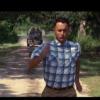Most of my field work solo is park at a trail head then head out. Get to the area of interest and find my way back to my vehicle. That sounds pretty simple but it is amazing how different things look just going the other direction on a trail. I try to note significant objects that I know I will see traveling both directions on a trail. Then as I come out it is comforting when I pass the landmarks. Off trail you need to reference major features like ridge lines and keep oriented with either the sun or compass. It is very important off trail to have a plan to find your way out. The most lost I have been was on cross county skis in a snow storm. The snow covered my tracks and I lost the trail. I basically had to use dead reckoning and follow a compass heading to find my way out. I hit the forest road my vehicle was parked on and had to guess which of two ways to the vehicle. The first guess was right and with the storm getting worse the wrong guess might have been tragic. That experience has stayed with me and I rarely go out with bad weather coming in. My experience with hand held GPS or cell phone maps is mixed. They can be confusing at times, seem to run out of battery when you most need them, in dense forest lose satellite view, and in areas without cell coverage you need a cell phone map app that allows the maps to be prestored in memory. When gadgets work most of the time you know where you are and don't need them. I guess I basally do not trust them because they have failed me when I needed them the most. I prefer a paper map and a compass for simple dependability.



